Dr. Claudio Padua is cofounder, with his wife Suzana, of the Institute for Ecological Research (IPE), which works on conservation projects throughout Brazil.
Monday, 12 Jan 2004
BANGALORE, India
This week will certainly be one of the most important of my professional life. We will be creating, together with other organizations, an alliance of mid-size NGOs from all over the world. This alliance is an idea that several colleagues and I have been nurturing for several years. It is finally going to become a reality at a meeting of all the organizations in Bangalore, in the south of India. Sponsored by the American organization Wildlife Trust, it has been organized by the Asian Nature Conservation Foundation.
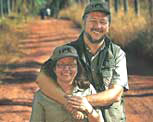
Suzana and Claudio.
Photo: IPE.
In the middle of our two-day journey to India, we made a stop in Wye, England. I say “we” because my wife Suzana is with me — we are partners not only in married life but also in our professional lives. Around 15 years ago, we founded the Institute for Ecological Research (IPE), a Brazilian NGO dedicated to conservation of the immense and spectacular biological and cultural diversity of my country. Our stop in England was linked to one of our activities at IPE: training young rural Brazilians in conservation science. Together with Wye College and the Catholic University of Rio de Janeiro, we’re organizing an Internet-based distance learning course we believe will be very important considering the immense size of our country and the difficulties faced by students far from major educational centers.
Our trip began with some of the missteps that are the drama of any traveller. We made a stop in Paris, and from there we had to go on to London without our baggage, which only arrived when we were preparing to leave for Bangalore. We therefore spent 36 hours in England in our travel clothes, using the flimsy single-use toilet kits and toothbrushes handed out on international flights.
But that’s water under the bridge, and at this moment I am in India, well-settled in a fine hotel and ready to participate in the workshop to create the Wildlife Trust Alliance. I am in the welcoming presence of my international colleagues, including Martin Acosta, coordinator of the Cuban Conservation Committee; Pablo Bordino, director of Aqua Marina in Argentina; Alida Madero, manager of Wild Ones/Los Jovenes Aventureros in Mexico; Lorena Calvo, executive director of the Center for the Conservation of Guatemalan Biodiversity; Ani Mardiastuti and Damayanti Buchori, leaders of PEKA Indonesia; Jon Paul Rodriguez, president of Provita in Venezuela; Rodrigo Medellin, director of the Institute of Ecology, University of Mexico; Prithiviraj Fernando, founder of a new research group in Sri Lanka; Mary Pearl, president of Wildlife Trust; and our host, R. Sukumar, managing trustee of the Asian Nature Conservation Foundation.
For the first part of the week, we are going to work together revising the framework for the Alliance. As soon as it is ready, it will be signed by everyone present. Then we will start work on a list of conservation actions we want to accomplish together and compose our first joint statement — a call for action that we think will have great international impact. For the second part of the week, Suzana and a smaller group will participate in a peer evaluation of the Asian Nature Conservation Foundation, which will give us the opportunity to visit their field work. The ANCF works primarily to save Asian elephants and diminish the conflict between wildlife and humans.

Finally, my pre-event anxiety is beginning to diminish. Today we had our first session, where as usual, everyone said a few words about themselves. Although in this group we all know each other, it is still an important moment because it helps break the ice before such an important occasion. We met in a salon of the hotel, seated together at a big U-shaped table.
This was followed by a presentation by our host, Professor Raman Sukumar, about the work of his organization in India. After that, the president of Wildlife Trust, Dr. Mary Pearl (who was a Grist diarist a few months ago) and I explained the week’s agenda. The last event of the day was an exercise facilitated by Suzana, based on a German participatory planning system known as “ZOPP.” Through this exercise, we draw out from the participants their expectations for the week’s work, and our objectives as well. This will be useful principally to ensure that the Wildlife Trust Alliance is incorporating everyone’s expectations and thus following the right path.
Tuesday, 13 Jan 2004
BANGALORE, India
What I envisioned yesterday came to pass: Today is one of the most important days in my professional life and it gives me great pleasure to share it with you, Grist readers.
After much work, we signed the accord that officially and definitively launches the Wildlife Trust Alliance, a network of eight mid-sized non-governmental organizations and several individuals. We have joined forces to: foster innovative conservation science and lasting local conservation; express a mutual commitment to practical, multidisciplinary programs at sites around the world; and facilitate joint ventures in research, policy design, and implementation, as well as in fundraising and mentoring.
Twelve years have passed since we first conceived the network. Some people say achievement requires 10 percent inspiration and 90 percent perspiration. My own version is similar: 10 percent inspiration, 10 percent perspiration, and 80 percent persistence. A more fatalistic way of seeing this is that goals are only achieved when the right moment arrives — sometimes ideas we have today will only be realized many years from now. Despite my philosophical digression, it is a fact that today we were able to achieve a highly desired objective, and it is time to open the champagne and raise a toast.
As life is made interesting by its details, what I am telling you might not be interesting if I don’t mention the steps we took to create the Alliance. I cannot cover the years of preparation, but at least I can tell you what happened today.
The morning session began with a lecture by my wife Suzana about the results of yesterday’s expectations exercise. We recognized through her analysis that there is consensus about the most important parts of the proposal. Still, some signs of concern led us to open up more discussion with the group so we could clarify or modify the formal document that defines the framework of the WTA. During this period, which took all morning, we had a few moments of tension, as always happens when a group must make decisions together about issues of common interest — especially a heterogeneous group representing different cultures.
The difficulties and differences of opinion from time to time required Mary Pearl and me to explain aspects of the framework in more detail; these were discussed exhaustively until there was agreement. There were moments of great anxiety and tension, but I went to lunch with the sense that consensus had been obtained. As my grandfather, a wise Brazilian politician, used to say, “A meeting can only be finished after everything has been agreed upon.”
The afternoon’s work was reading the establishing framework document item by item, chapter by chapter, until everyone was in harmony about its content. Instrumental to the success of this session was Martin Kaplan, a member of Wildlife Trust’s board of directors and a partner in the prestigious law firm of Hale and Dorr, where initial drafts of the document were prepared. Suzana took on the role of secretary and kept up with the changes in the document as discussion went on.
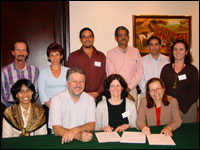
Sign of the times.
The afternoon coffee break had to be delayed so that we could continue our work, which was advancing so well. Finally, the document was accepted by everyone. During the break, it was printed and photocopied, and when we returned we signed it. I hope you can see from the photograph how happy we all were at that moment.
But the day was not finished yet. After signing the framework, we still had to make initial preparations for the program evaluation of our Indian partner, the Asian Nature Conservation Foundation.
What a day, what a day. I don’t know if readers agree, but there are not many days in which one has the sensation that one’s life really matters. This was one of those days. I am so drained of energy after so much work and anxiety that only a break can bring me back to reality. Tomorrow, happily, I can be a tourist and get to know Bangalore a little bit — and describe it to you.
Wednesday, 14 Jan 2004
BANGALORE, India
When the average person has a day off, it usually involves rest and relaxation. No one wants to miss a chance to sleep late, wake up, stretch, and lay in bed thinking or dreaming before getting up. No one likes to lose a chance to refresh and savor laziness. Wildlife specialists like me aren’t different, you see, except that one of our greatest pleasures is observing wildlife, which must take place principally at dawn or dusk.
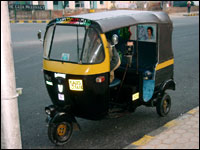
Taxi!
I say this so readers understand why at 6:30 a.m. Suzana and I were already in the lobby of our hotel ready for a visit to Lal Bagh, the botanical garden of Bangalore, with our colleagues from the Wildlife Trust Alliance — guided by Basker, one of the kind and efficient researchers at the Asian Nature Conservation Foundation. The objective for the day was to do a little tourism, so we resolved to follow the maxim, “When in Rome, do as the Romans do.” We divided into groups to take small local taxis that are like little jails on wheels, with motorcycle motors and uniformed drivers as crazy as the traffic patterns in Bangalore.
Sweating adrenaline, we took one of these motorized bowling balls through the streets of Bangalore toward the garden. The adventure was more than worth it: The park is big for an urban center, with 240 reasonably well-conserved acres, great scenic beauty, numerous trees, and fantastic, easily spotted animals. We walked around for several hours among locals taking their morning jog or daily meditation, observing the fauna and flora. The return trip was as adventurous as the ride in, and hungry from the walk, we were well-compensated by a big, energy-restoring breakfast.
The remainder of the morning was dedicated to visiting various tourist centers in Bangalore, such as the Governor’s Palace, the market, the Temple of the Bull, and the Palace of the Sultan. In the early afternoon, we were taken to a restaurant serving local specialties. The tables were cafeteria-sized and the plates were enormous. The waiters came around with pots of food and served everyone by tossing big servings on our plates. The food was delicious, with huge portions, and we ate what they gave us — with our hands, as is the custom here.
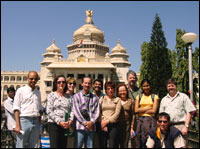
Sightseers for sore eyes.
The rest of the afternoon was dedicated to shopping. Suzana and I bought a very pretty rug, although it gives me pause to think of carrying it back on the long trip home to Brazil. I know that once it is in our house we will appreciate how beautiful it is. Still, I must confess that lugging the thing home is not a task I’ll enjoy.
Our day ended with a typical dinner in the house of a colleague, Parveen, who works with tigers. His lovely wife and pretty daughter welcomed us warmly, and we enjoyed the company of a couple of his friends. Again the meal was delicious, with many local specialties.
The night was fun, but I must confess that I am tired and tomorrow will be challenging — we will be working on the Wildlife Trust Alliance’s first joint declaration, followed by a press conference. It will also be the day of our banquet, with a regional dance. I am looking forward to this event and will tell you all about it tomorrow.
While it may seem like a waste of precious time together to have a day of leisure, these enjoyable hours with colleagues from around the world mean that our serious discussions tomorrow will go much more smoothly. Mutual affection and trust go a long way toward helping to resolve differences of opinion.
Thursday, 15 Jan 2004
BANGALORE, India
Today was exhilarating — and exhausting, because no activity requires more intellectual and emotional energy than actively listening and responding fully and honestly in a debate among sincere and passionate people. Today we worked on the first official act of the Wildlife Trust Alliance: a joint expression of our common concern about the damaging effects of the wildlife trade.
It started quite simply: My colleague Jon Paul Rodriguez — the president of Provita, the Wildlife Trust Alliance member in Venezuela, and an authority on wildlife trade between South and North America — had written a draft declaration calling for a ban on such trade because it damages wildlife populations and encourages criminal behavior. A group of us — including Mary Pearl of Wildlife Trust and Peter Daszak of Wildlife Trust’s Consortium for Conservation Medicine — felt that increasing evidence of the role of wildlife transport in disease emergence presented a new and compelling reason to stop all trade of pets and food. What justification can there be to indulge people who want to house wild animals when the cost might be the health of their family members, their pets, and local wildlife?
We circulated the draft declaration a week before the Alliance meeting and asked people to bring comments and evidence of the effect of wildlife trade in their own countries.
Well, if I thought approval of the document would be swift and painless, I was wrong! Every member of the Alliance is strong, independent, and opinionated. Those of us in favor of an outright ban were asked to consider the livelihoods of local communities dependent on some form of trade in wildlife. We were asked to think about the effect of an immediate ban on enforcement agencies around the world without sufficient resources or training. Feelings grew so heated that several members stated that they could not sign a document calling for an all-out ban.
At the same time, we all agreed that wildlife trade has and will continue to create severe disasters in public health. It was time to compromise so that we could begin to take steps to address this crisis as a team.
We agreed to state that, as a group of top local conservation scientists from around the world, the Wildlife Trust Alliance has found considerable evidence that wildlife trade can threaten human and animal health. We agreed to work toward seven key steps to halting the spread of disease through wildlife trade.
I cannot deny that I was disappointed that we did not agree to call for an outright ban, but sometimes the best strategy is to be pragmatic and achieve the most possible as a first step.
The ink from our signatures was barely dry when the time came for our press conference. About a dozen members of the press and a national television station came. Sukumar, our host, spoke first, describing our call to improve disease surveillance, promote adequate quarantine procedures, conduct research on the risk of disease transmission, and strengthen legislation, enforcement, and capacity for oversight of animal transport and trade. Then Mary Pearl and I discussed the creation of the Alliance. And Peter Daszak spoke about the diseases emerging from transported species.
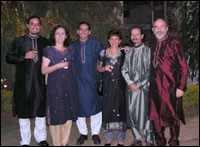
When in Bangalore…
We could not have made our announcements in a more receptive atmosphere. Indian journalists impressed us as knowledgeable and interested in environmental issues — and curious about the fact that conservationists from as far away as Guatemala, Brazil, and Cuba would join forces with the Bangalore-based Asian Nature Conservation Foundation.
What a positive end to a difficult work day!
With high spirits and camaraderie restored, we prepared for our banquet. As a sign of respect and solidarity with our Indian hosts, all of us, large and small, fat and thin, wore Indian clothing we purchased for the occasion. We were entertained with a fascinating drama that incorporated Indian classical music and dance. One of the younger members of the ANCF, Nandita, danced the title role with grace and beauty, together with the young ladies of a local dance academy. The evening ended with toasts and good cheer.
Saturday, 17 Jan 2004
BANGALORE, India
Here we are at the end of one of the most exciting weeks of my life. After years of theorizing and building relationships with colleagues with the same vision but very different cultures, we have created the Wildlife Trust Alliance. Finally, strong-minded conservationists passionately committed to local community-based conservation have both the independence to build our own unique programs and the mutual support that comes from being part of an international movement.
To put the icing on the cake, we have also accomplished an important early milestone: Alliance members spoke with one voice to draw attention to a critical issue in conservation. The press has taken notice, too: Several of us were on national Indian television today talking about both the formation of the Wildlife Trust Alliance and our first declaration highlighting the wildlife trade and the problems it creates in our countries.
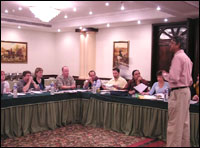
The fun rolls to an end.
Our last session was this morning. We started out by taking care of some business, voting on a number of individuals and institutions to invite into the Alliance and discussing the creation of an advisory council and what characteristics we would seek in a group of advisors.
We then came to the most important part of the discussion: What are the products we will produce as a group? We have to balance our excitement at being part of a collaborative with awareness that we need enough time to accomplish our work on the ground at home. Suzana led another ZOPP exercise, in which everyone wrote down their ideas for products. During a tea break, she organized the dozens of cards, and when we sat down together again, we saw that our suggestions fell primarily into four categories: publications, capacity building, fundraising, and providing policy-relevant scientific information to decision-makers. We were all issued stickers to place on our top five ideas. Lo and behold, our priorities were identified!
Over the next six months, Mary Pearl and I, as coordinators of the Alliance, will be working with our colleagues to make specific plans to achieve these priorities. When the Alliance meets next, in July, we will go over these plans to move to action. We will also assess how well we have implemented the agenda we proposed in our declaration, and reassess the deleterious effects of the wildlife trade.
Dear readers, it has been a pleasure to share this important week with you. This afternoon I head off with Sukumar and a team of peer evaluators to observe his research program in the field, at Mudumalai National Park. I can hardly wait to see my first wild elephant … and then next week, Suzana and I return to our conservation work in Brazil with renewed commitment and energy.


